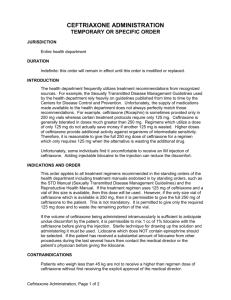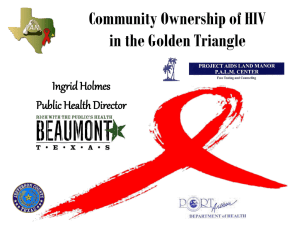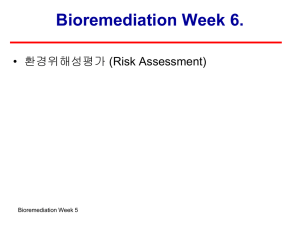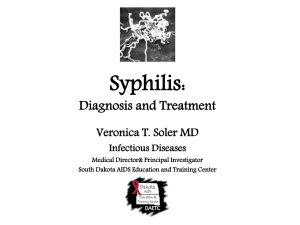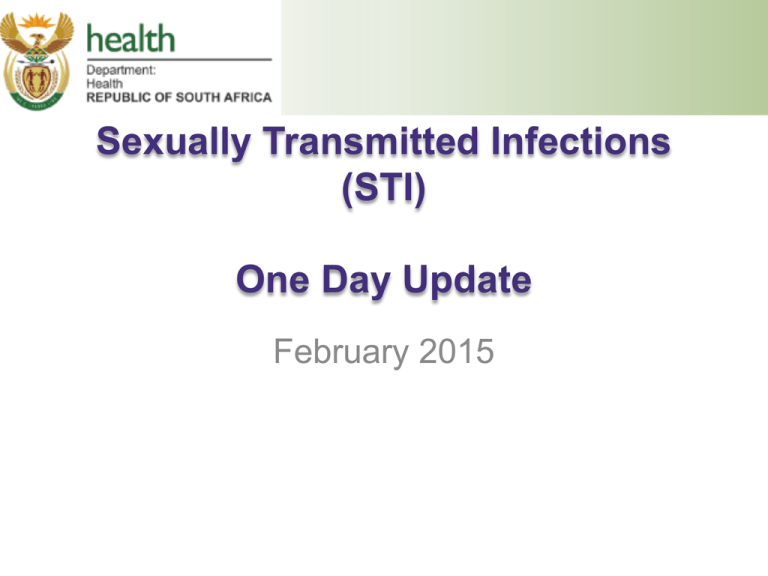
Sexually Transmitted Infections
(STI)
One Day Update
February 2015
Overview
• STI Guideline Changes
• National STI Services Results Reporting
• High Transmission Areas: Key Populations
STI Guideline Changes
February 2015
Significant Changes
Significant Changes
• Cefixime no longer in guidelines, changed to
Ceftriaxone IM
• Doxycycline no longer in guidelines for use
other than for PCN allergy in syphilis and
BAL, changed to Azithromycin
• Ciprofloxacin no longer in guidelines for
penicillin allergy
• Ceftriaxone IM and Benzathine
Benzylpenicillin IM to be dissolved in
lidocaine 1% without epinephrine to assist
with pain management of dosing
Rationale for Ceftriaxone IM
• Ceftriaxone 250mg IM is highly efficacious at
treating N. gonorrhoeae at all anatomical
sites
• Increasing resistance of gonococcal strains to
cefixime and ciprofloxacin
• An IM dosing improves adherence
• One previous barrier was the possible patient
complaint of pain, no longer an issue when
diluted with lidocaine (w/out epinephrine)
Rationale for Azithromycin
• Effective for chlamydial infection and postgonococcal urethritis
• Combination therapy may improve efficacy
and delay emergence of resistance
• Preferred to doxycycline
• Improved adherence
• Higher gonoccocal resistance to doxycycline
Specific Changes by Algorithm
Vaginal
Discharge
Syndrome
(VDS)
VDS – Specific Changes
• Age < 35 or Partner with MUS as new criteria
instead of patient sexually active in past 3
months.
• If patient does not meet either of these criteria
consider vaginal candidiasis and/or bacterial
vaginosis
• If there is no response to initial treatment provide
Metronidazole, oral, 400 mg, 12 hourly for 7 days
• If patient does meet criteria, confirm abnormal
DISCHARGE, no longer vulval itching or burning
VDS – Specific Changes (2)
• Treatment for VDS has changed from Cefixime and
Doxycycline to for all, including pregnant women:
•
•
•
•
Ceftriaxone, IM, 250 mg as a single dose AND
Azithromycin, oral, 1 g as a single dose AND
Metronidazole, oral, 2g as a single dose
If vulva oedema/curd-like discharge, erythema,
excoriations – Clotrimazole vaginal pessary 500mg 1x
• If vulval irritation is severe treat with Clotrimazole
vaginal cream applied 12 hourly x 3 days after
symptoms resolve (maximum 2 weeks)
• If no response, Metronidazole, oral, 400 mg 12 hourly
for 7 days
Ceftriaxone IM Injection
• Ceftriaxone IM 250mg should be dissolved
in 0.9 mL lidocaine 1% without epinephrine
(adrenaline)
• Dissolving with lidocaine will decrease
pain associated with the injection of the
antibiotic
• Note this is only for IM dosing of
Ceftriaxone, IV dosing should NOT be
diluted with lidocaine
VDS Specific Changes (2)
• If an allergy to penicillin omit ceftriaxone and
increase azithromycin dose to 2g oral as a
single dose
• NO longer give Ciprofloxacin
• Additionally, indications are included
reminding practitioners to obtain a pap smear
following treatment according to screening
guidelines
• A note is included to refer all suspected STIs
in children to the hospital for further
management
Lower
Abdominal
Pain (LAP)
LAP Specific Changes
• Diagnostic and exclusionary criteria for LAP
remain the same
• For severely ill patients management remains
primarily the same
• However, do NOT dilute IV Ceftriaxone with lidocaine
• Treatment for non-severely ill patients now
includes the following:
• Ceftriaxone IM 250 mg single dose AND
• Azithromycin, oral, 1 g as a single dose AND
• Metronidazole, oral, 400 mg 12 hourly for 7 days
NOTE – Doxycyline is no longer part of the regimen and
has been substituted with Azithromycin
LAP Specific Changes (2)
• Treat pain with Ibuprofen, oral, 400 mg 8 hourly
with food
• Follow-up at 48-72 hours remains
• Check for improvement after 7 days, including
referral if no improvement has been added
• Ensuring full improvement is essential to prevent
severe complications!
• Similar to VDS, no longer give ciprofloxacin in the
case of penicillin allergy, rather increase
azithromycin dose to 2g orally as a single dose
and omit ceftriaxone
Male
Urethritis
Syndrome
(MUS)
MUS Specific Changes
• A history of sexual orientation is included
• MSM are more likely to develop drug resistant
cases
• Partner tracing is emphasised throughout
• ONLY patients with DISCHARGE will be
treated
• Not the patients with complaints of dysuria and
NO discharge or without evidence of discharge
• Still treat presumptively if partner has MUS or
VDS
MUS Specific Changes (2)
• Treatment for MUS has changed from Cefixime
and Doxycycline to:
• Ceftriaxone, IM, 250 mg as a single dose (dissolved
in 0.9 mL lidocaine 1% without epinephrine) AND
• Azithromycin, oral, 1 g as a single dose AND
• If sexual partner has VDS, Metronidazole, oral, 2g as
a single dose
• If an allergy to penicillin omit ceftriaxone and
increase azithromycin dose to 2g oral as a single
dose
• NO longer give Ciprofloxacin
MUS Specific Changes Resistance
• If urethral discharge persists after 7 days:
• Suspect treatment failure
• Treat with the following:
• Ceftriaxone, IM, 1 g single dose (dissolved in 3.6mL
lidocaine 1% without epinephrine) AND
• Azithromycin, oral, 2 g as a single dose AND
• Metronidazole, oral 2 g as a single dose (if not
already given)
• If PCN allergy omit ceftriaxone and refer for
gentamicin plus azithromycin
• Refer all ceftriaxone treatment failures within 7
days for gentamicin, IM, 240 mg as a single dose
Scrotal
Swelling
(SSW)
SSW Specific Changes
• Treatment for SSW has changed from
Ceftriaxone and Doxycycline to:
• Ceftriaxone, IM, 250 mg as a single dose
(dissolved in 0.9 mL lidocaine 1% without
epinephrine) AND
• Azithromycin, oral, 1 g as a single dose
• If PCN allergy, omit ceftriaxone and increase
azithromycin to 2 g orally as a single dose (no
longer giving ciprofloxacin)
• If pain, Ibuprofen, oral, 400 mg 8 hourly with
food may be dispensed
Genital
Ulcer
Syndrome
(GUS)
GUS Specific Changes
• Examination specifically mentions ulcers
• If ulcers present, look for buboes
• If bubo is present – use bubo flowchart
• Emphasis on HIV status directing aciclovir
management
• Requires asking HIV status and recommending
testing if unknown
• If no sexual activity, and patient is HIV positive or of
unknown status treat with aciclovir, oral, 400 mg 8
hourly x 7 days
• If no sexual activity and HIV negative – do NOT treat
for HSV, consider another etiology
Herpes Simplex Virus- 2 and
HIV
• Persons living with HIV are more likely to
have HSV-2
• The 2012 Antenatal HIV and HSV Survey
showed an overall estimated HSV
prevalence among antenatal clients in
KZN, NC, GP and WC
• 42.5% if HIV negative
• 89.1% if HIV positive
GUS Specific Changes (2)
• If ulcer but no bubo and sexually active within
the past 3 months
• Continue to treat with Benzathine benzylpenicillin,
IM, 2.4 MU immediately as a single dose
• Dissolve in 6 mL lidocaine 1% without
epinephrine
• If HIV+ or unknown status, add aciclovir, oral 400
mg 8 hourly for 7 days
• Review ALL cases in one week
GUS Specific Changes (3)
• If no improvement:
• Treat and then refer if no response within 48 hours
• Treat with Azithromycin, oral, 1g as a single dose
• If PCN allergy:
• Perform baseline RPR
• Continue to replace benzathine benzylpenicillin with
doxycycline, oral, 100 mg 12 hourly x 14 days
• Return for a follow-up RPR in 6 months or later
• If pregnant or breastfeeding, refer for confirmation of
new syphilis infection and possible penicillin
desensitisation
Bubo
(BUB)
Bubo specific changes
• If bubo is confirmed no longer treat with
Doxycyline and Ciprofloxacin, instead treat
with:
• Azithromycin, oral, 1 g immediately and 1 g a
week later
• No longer provide additional treatment if
also an ulcer
• Refer if no improvement after 14 days
Balanitis/
Balanoposthitis
(BAL)
BAL specific changes
• In examining, note if there is a profuse
collection of watery pus under the foreskin
that is not coming from the uretha
• If present, additionally treat with Benzathine
benzylpenicillin, IM, 2.4 MU immediately as a single
dose
• Dissolve in 6 mL lidocaine 1% without epinephrine
• If PCN allergic replace benzathine benzylpenicillin
with Doxycycline, oral, 100 mg 12 hourly x 14 days
• Provide MMC Counselling
Syphilis
Syphilis Specific Changes
• RPR indications:
• Indicated in 6 month follow-up of early syphilis
case treated with doxycyline (see GUS algorithm)
• No longer indicated for 3 month follow-up of
recently treated early syphilis cases
• Clarification in algorithm of what is
considered an early or a late syphilis case
• Dissolving benzathine benzylpenicillin 2.4MU
in 6 mL lidocaine 1% without epinephrine
Syphilis Specific Changes (2)
• An added emphasis on the following for
early AND late syphilis:
• Recording the titre on patient’s record (as this
is necessary for potential future
presentations)
• Issuing a partner notification slip
• Repeating RPR in 6 months if treated with
doxycycline
Syphilis in
Pregnancy
Syphilis in Pregnancy
Specific Changes
• Rapid syphilis screening recommended
• Repeat screening at 32 weeks in women testing
negative in first trimester
• HIV testing and result indications aligned with
new ART guidelines
• Reconstitution of Benzathine benzylpenicillin
with lidocaine 1% without epinephrine
• Follow-up at 3 months to confirm fourfold
reduction in RPR
Syphilis in Pregnancy
Specific Changes (2)
• Refer all symptomatic newborns
• Treat asymptomatic newborns of mothers
with a positive syphilis test if:
• Mother not treated
• Mother did not receive all 3 doses
• Mother delivers within 4 weeks of
commencing treatment
Neonatal
Conjunct
-ivitis
Neonatal Conjunctivitis
Specific Changes
• Treatment varies based on severity
• Erythromycin no longer utilised
• Chloramphenicol 1% opthalmic ointment in non-purulent
cases
• Sodium chloride 0.9% eye washes in purulent cases
• Frequency depending on severity
• Ceftriaxone in purulent cases
• Immediate referral in purulent cases
• Maternal/Paternal treatment aligns with new MUS and
VDS guidelines
Changes to Genital Warts and
Related Conditions
• Genital warts – If condyloma lata is
suspected (i.e. NOT typical or ARE
fleshy/wet) perform an RPR/VDRL to
exclude syphilis
• Pubic Lice/Scabies – Benzyl benzoate first
line treatment, permethrine generally
unavailable
Questions?
Cases – Putting New
Information into Practice
Case 1: Sipho
• Sipho is a 24 year old male. He comes to
your clinic complaining of dysuria.
• What do you need to ensure you ask when
taking a history?
• What will be part of your physical
examination, including laboratory studies?
Case 1: Sipho (2)
• Consider MUS
• Ask about sexual orientation
• Examine for:
– Discharge, if none visible ask patient to milk the urethra
– Any other STIs
– HIV if status negative or unknown
Case 1: Sipho (3)
• Sipho tells you he has experienced dysuria and
discharge for the past 2 days. He does not have
any other signs and symptoms. He is HIV+. He
tells you he has had both male and female
sexual partners in the past three months. As far
as he is aware, none of his partners has had an
STI recently. No drug allergies.
• On examination discharge is present. There is
no evidence of ulcers, rashes, scrotal swelling or
buboes
Case 1: Sipho (4)
• How will you treat Sipho?
• If Sipho had not had discharge, under
what other circumstance would you still
treat for MUS?
Case 1: Sipho (5)
• Treatment should include:
– Ceftriaxone, IM, 250 mg
single dose dissolved in
0.9ML lidocaine 1%
without epinephrine
– AND Azithromycin, oral,
1 g as a single dose
– Since he does not have
a partner with VDS, you
would NOT add
Metronidazole
Case 1: Sipho (6)
• If Sipho returns in 7 days with persistent
discharge, what will you suspect?
• What aspect of Sipho’s history increases
your suspicion of potential treatment
resistance?
• What would you do next?
Case 1: Sipho (7)
• Cases of treatment
failure, regardless of
the reason, should be
treated as follows:
– Ceftriaxone, IM, 1 g
single dose, dissolved in
3.6 mL lidocaine 1%
w/out epinephrine
– AND Azithromycin, oral,
2 g as a single dose
– AND Metronidazole,
oral, 2 g as a single dose
Case 2: Dikeledi
• Dikeledi is a 35 year old female. She
complains of painful sores.
• In order to follow the algorithm, what two
items will be key in your history taking?
• For what will you examine, including
laboratory testing?
Case 2: Dikeledi (2)
• In addition to other
questions, it is key to ask
about
– HIV status and sexual
activity in the past 3
months
• An examination should
assess for:
– Ulcers AND buboes
– HIV test offer
– Any additional STIs
Case 2: Dikeledi (3)
• Dikeledi reports no other signs or symptoms.
She is allergic to PCN. She has been sexually
active with one male partner in the past 3
months. She is HIV+, not on ART. She does not
know if her partner has any signs or symptoms
of STIs. She is not pregnant.
• On exam, she has several small painful ulcers
on her vulva. No buboes. No discharge, rashes
or other signs noted.
Case 2: Dikeledi (4)
• What will you do next?
Case 2: Dikeledi (5)
• Since PCN allergic:
– Baseline RPR
– Replace benzathine
penicillin with doxycycline,
oral, 100 mg 12 hourly for
14 days
– Return for follow-up RPR in
6 months
• Since HIV +:
– Aciclovir, oral, 400 mg 8
hourly for 7 days
– Assess for ART start and
engage in HIV care
• Since painful:
– Pain relief
Integration of Care
Screening for STIs
• All patients ages 15-49 should be
screened for STIs regardless of clinical
presentation
• Ask the following 3 questions:
• Do you have any genital discharge?
• Do you have any genital ulcers?
• Has/have your partner(s) been treated for an
STI in the last 8 weeks?
The Cs
• Counselling and education, including HIV testing
• Condom promotion, provision and
demonstration
• Compliance with treatment (including ART)
• Contact treatment/partner management
• Circumcision (medical) for eligible men
• Cervical cancer screening
• Contraception and conception counselling
Framework for the prevention and control of
STIs in the SADC region
Additionally…
• Post Exposure Prophylaxis
• HPV vaccination
• Appropriate prenatal care including
syphilis and HIV screening and receipt of
results in a timely manner
Screen for STIs at every visit!
And
Ensure the capability of
providing appropriate
treatment

